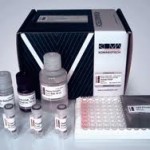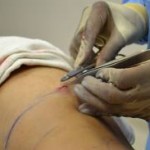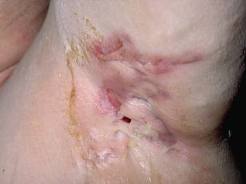Hidradenitis suppurativa is a persistent swelling of the skin manifested by the occurrence of blackheads and one or more red and tender lesions. The lesions are frequently increases in size, break open and drain pus. Repeated appearance of hidradenitis suppurativa may result to scars. Hidradenitis suppurativa rises deeply in the skin just about the oil glands and hair follicles. The parts of the body that mostly affected are the groin and armpits since it is considered as the main site of apocrine sweat glands.
Hidradenitis suppurativa have a tendency to start after puberty, continue for years and get worse over a period of time. Early determination and treatment of hidradenitis suppurativa can be very helpful to control the symptoms and avoid occurrence of new lesions.
What are the symptoms of hidradenitis suppurativa?
Hidradenitis suppurativa normally arises around the hair follicles wherein plenty of oil and sweat glands are found. These are the armpits, groin and anal area. It can also grow in parts of the body where skin rubs together like the inner thighs, between the buttocks and under the breasts. Hidradenitis suppurativa can have effect on a single part or several areas of the body.
Signs and symptoms of hidradenitis suppurativa may include the following.
- There is occurrence of blackheads that frequently appears in pairs.
- There is a red and tender lesions that frequently increases in size, break open and drain pus. The drain may have a horrible odor. This lesion may be itchy, has burning sensation and accompanied with excessive sweating.
- There is occurrence of hard lumps underneath the skin that may continue for years, enlarge and become swollen.
- This leaking lump heals very gradually and frequently leads to scarring with the growth of tunnels underneath the skin.
Hidradenitis suppurativa frequently begin at teenage years with one painful lump that persist for weeks or even months. For some people affected with it, it increasingly gets worse and has effects on several parts of the body. Some experience only mild symptoms. Stress, excessive weight, hormonal changes, too much perspiration and heat can make the symptoms get worse.
What are the causes of hidradenitis suppurativa?
Hidradenitis suppurativa grow when the sebaceous gland and hair follicle happen to be obstructed by fluid, dead skin cells and other substances that are being released coming from surrounding apocrine sweat glands. Once these substances combine with the oil from the sebaceous glands and they can be cornered drive into surrounding tissue. Bacteria can cause the swelling and infection. It is not yet known why this obstruction takes place but there are reasons to be considered like genetics, hormones, excessive weight and cigarette smoking.
What is the risk factors affecting hidradenitis suppurativa?
The following factors are the most frequently have greater possibility of developing hidradenitis suppurativa.
- Gender. Women are more prone to have hidradenitis suppurativa than men. The reason behind this is not yet known.
- Age. Hidradenitis suppurativa usually affects adults with more than 40 years of age. It rarely has an effect on children.
- Genetics. If hidradenitis suppurativa runs in the family, you have greater possibility of having the disorder.
What are the treatments of hidradenitis suppurativa?
The treatment for hidradenitis suppurativa is not yet known. However, early application of treatment can help to control the symptoms and help to avoid new occurrence of lesions. The possible medications may include the following.
1.    Intake of antibiotics.
 Intake of antibiotics for a long time in the early onset of the illness can help to fight against the infection. It may also help to avoid the disease in getting worse.
Intake of antibiotics for a long time in the early onset of the illness can help to fight against the infection. It may also help to avoid the disease in getting worse.
2.    Intake of oral retinoid medications.
 Oral retinoid medications help to stop the oil gland functions. These medications help to avoid the blocking of hair follicles.
Oral retinoid medications help to stop the oil gland functions. These medications help to avoid the blocking of hair follicles.
3.    Intake of nonsteroidal anti-inflammatory drugs.
 Nonsteroidal anti-inflammatory drugs help to lessen the pain and inflammation.
Nonsteroidal anti-inflammatory drugs help to lessen the pain and inflammation.
4.    Intake of corticosteroids or immunosuppressant drugs.
 These medications may help to lessen the swelling particularly in the early onset of hidradenitis suppurativa.
These medications may help to lessen the swelling particularly in the early onset of hidradenitis suppurativa.
5.    Administering of tumor necrosis factor or TNF-alpha inhibitor.
 These medications may demonstrate an assurance in the treatment of hidradenitis suppurativa. However, this can only be used in short term basis due to the risks involved with the long term use.
These medications may demonstrate an assurance in the treatment of hidradenitis suppurativa. However, this can only be used in short term basis due to the risks involved with the long term use.
6.    Do incision and drainage.
 Removal of the lesions or surgical drainage may be an alternative when the illness engages only one small spot. But this treatment won’t avoid the illness from recurring and is commonly used only for short-term relief.
Removal of the lesions or surgical drainage may be an alternative when the illness engages only one small spot. But this treatment won’t avoid the illness from recurring and is commonly used only for short-term relief.
7.    Application of surgical treatment.
 Surgical treatment of persistent or extreme symptoms involves the removal of all affected skin followed by direct closure with skin grafting. Complete surgical removal of the involved part of the skin can cure the disorder that is present but does not prevent it from developing in other parts of the body.
Surgical treatment of persistent or extreme symptoms involves the removal of all affected skin followed by direct closure with skin grafting. Complete surgical removal of the involved part of the skin can cure the disorder that is present but does not prevent it from developing in other parts of the body.
Early treatment of hidradenitis suppurativa can be very helpful to relieve the symptoms. Self-care measures can be applied if only mild hidradenitis suppurativa is involved. Do not hesitate to ask your doctor of what treatment can be appropriate with your present condition.
